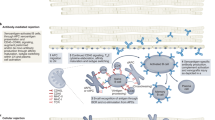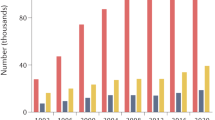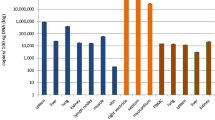Abstract
Hearts from α1,3-galactosyltransferase knockout pigs (GalT-KO, n = 8) were transplanted heterotopically into baboons using an anti-CD154 monoclonal antibody–based regimen. The elimination of the galactose-α1,3-galactose epitope prevented hyperacute rejection and extended survival of pig hearts in baboons for 2–6 months (median, 78 d); the predominant lesion associated with graft failure was a thrombotic microangiopathy, with resulting ischemic injury. There were no infectious complications directly related to the immunosuppressive regimen. The transplantation of hearts from GalT-KO pigs increased graft survival over previous studies.
This is a preview of subscription content, access via your institution
Access options
Subscribe to this journal
Receive 12 print issues and online access
$209.00 per year
only $17.42 per issue
Buy this article
- Purchase on Springer Link
- Instant access to full article PDF
Prices may be subject to local taxes which are calculated during checkout

Similar content being viewed by others
References
Good, A.H. et al. Transplant Proc. 24, 559–562 (1992).
Cooper, D.K.C. Clin. Transplantation 6, 178–183 (1992).
Oriol, R., Ye, Y., Koren, E. & Cooper, D.K.C. Transplantation 56, 1433–1442 (1993).
Lin, S. et al. Transplantation 70, 1667–1674 (2000).
Cooper, D.K.C., Koren, E. & Oriol, R. Lancet 342, 682–683 (1993).
Phelps, C.J. et al. Science 299, 411–414 (2003).
Kolber-Simonds, D. et al. Proc. Natl. Acad. Sci. USA 19, 7335–7340 (2004).
Dor, F.J.M.F. et al. Transplantation 78, 15–20 (2004).
Kuwaki, K. et al. Am. J. Transplant. 4, 363–372 (2004).
Teranishi, K., Manez, R., Awwad, M. & Cooper, D.K.C. Xenotransplantation 9, 148–154 (2002).
Robson, S.C., Cooper, D.K.C. & d'Apice, A.J.F. Xenotransplantation. 7 166–176 (2000).
Kawai, T., Andrews, D., Colvin, R.B., Sachs, D.H. & Cosimi, A.B. Nat. Med. 6, 114 (2000).
Knosalla, C., Gollackner, B. & Cooper, D.K.C. Transplantation 74, 416–417 (2002).
Mueller, N. et al. J. Virol. 76, 4734–4740 (2002).
Bühler, L. et al. Transplantation 72, 1743–1752 (2001).
Acknowledgements
We thank L. Buhler and C. Knosalla for their comments on this manuscript, and R. Colvin for comments on the histopathology. We also thank W. Schuler and his colleagues at the Novartis Institutes for Biomedical Research for making ABI793 available to us, and P. Albientz, R. Buergi and F. Legay for developing the assay to measure levels of ABI793. Y-L Tseng is a recipient of a grant from the National Cheng Kung University Hospital, Taiwan. F.J.M.F. Dor is a recipient of grants from the Ter Meulen Fund from the Royal Netherlands Academy of Arts and Sciences, the Prof. Michaël-van Vloten Fund, and the Netherland-America Foundation. D.H. Sachs, J.A. Fishman, S.C. Robson, K. Yamada and D.K.C. Cooper were consultants to Immerge BioTherapeutics, Inc. This work was supported in part by US National Institutes of Health Program Project 1PO1A45897 and by a Sponsored Research Agreement between the Massachusetts General Hospital and Immerge BioTherapeutics, Inc.
Author information
Authors and Affiliations
Corresponding author
Ethics declarations
Competing interests
The following authors were employees at Immerge BioTherapeutics, Inc. at the time of the study: Akira Shimizu, Todd M. Sanderson, Jan Cheng, Kathleen Moran, Julia L. Greenstein, Robert J. Hawley, Clive Patience, Michel Awwad, and Henk-Jen Schuurman.
The following authors were consultants of Immerge BioTherapeutics Inc. at the time of the study: David H. Sachs, Jay A. Fishman, Simon C. Robson, Kazuhiko Yamada, and David K.C. Cooper.
Supplementary information
Supplementary Fig. 1
T cell (a) and B cell (b) counts until the time of excision of the graft in the baboons of Group 1. (PDF 105 kb)
Supplementary Fig. 2
Levels of anti-Gal IgM (a) and IgG (b) reactive with Gal type 6 during first 120 days or until the time of excision of the graft. (PDF 75 kb)
Supplementary Fig. 3
Representative mixed lymphocyte reactions, performed as reported previously22 (pre-transplantation, and on days 28, 70, 119 and 153) in B223, which underwent graftectomy and discontinuation of immunosuppressive therapy on day 110. (PDF 75 kb)
Rights and permissions
About this article
Cite this article
Kuwaki, K., Tseng, YL., Dor, F. et al. Heart transplantation in baboons using α1,3-galactosyltransferase gene-knockout pigs as donors: initial experience. Nat Med 11, 29–31 (2005). https://doi.org/10.1038/nm1171
Received:
Accepted:
Published:
Issue Date:
DOI: https://doi.org/10.1038/nm1171
This article is cited by
-
Cardiac Xenotransplantation: a New Frontier for Advanced Heart Failure
Current Treatment Options in Cardiovascular Medicine (2023)
-
Genetic Engineering of Donor Pig for the First Human Cardiac Xenotransplantation: Combatting Rejection, Coagulopathy, Inflammation, and Excessive Growth
Current Cardiology Reports (2023)
-
First pig kidneys transplanted into people: what scientists think
Nature (2022)
-
Progress in xenotransplantation: overcoming immune barriers
Nature Reviews Nephrology (2022)
-
The immunobiology and clinical use of genetically engineered porcine hearts for cardiac xenotransplantation
Nature Cardiovascular Research (2022)



